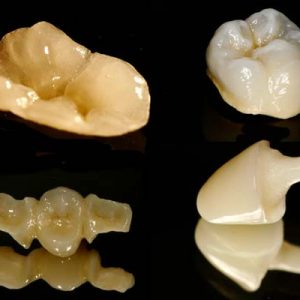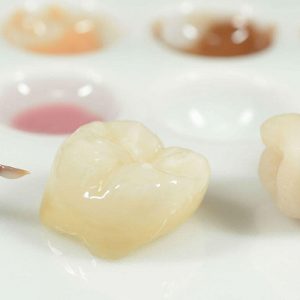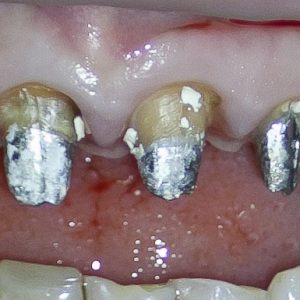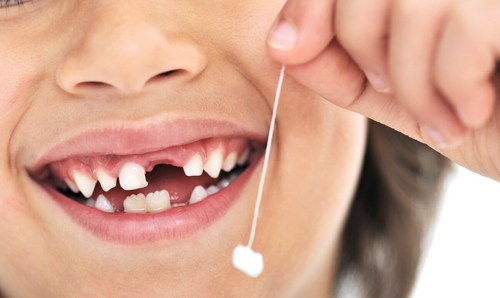Regenerative design mimics the anatomical shape of the tooth, returns him to the functional activity and prevents further destruction.
If the root (roots) of the tooth will not require additional treatment, and the crown part is severely damaged as the result of carious process, the best option for restoration is micro-prosthetics with the help of dental inlays.
It gives the opportunity to reconstruct the chewing surface, and in the future will help fix the prosthetic structure.
Tab is a big seal, but it is made by a qualified technician according to the previously completed physician impression (impression).
How is manufacturing and production tabs?
In the first step the dentist makes a thorough inspection of the entire oral cavity, and dissects the problematic tooth in order to remove all decayed tissue. Then the patient’s tooth is removed impression material, not giving even minimal shrinkage. Based on it using modern digital technology to create a model, which made a microdenture.

When you create ceramic models at the initial stage by the method of pressing is performed with a porcelain frame. Then it is applied in layers special ceramic material structure is baked in a special oven at high temperature

Metal tabs make models of technical wax, and zirconium are made with computer modeling and milling using the most advanced techniques of CAD/CAM.
Composite micro-prosthetics using a plaster tooth model, molded from a cast. They harden under the action of light (similar to ceramic seals) or by heating.
For best adhesion models are sandblasting.
During repeat visits to the specialist fitting tabs on the subject of perfect fit to the prepared cavity. The final stage is the fixing of microdenture with cement or a special dental glue, grinding and polishing.
Variety retail
According to the adopted classification according to the purpose all of the tabs are divided into cultivee and recovery.

Cultivee varieties are used when a significant destruction of the tooth, and further serve as a support for metal-ceramic or metal crowns. They represent a consolidated or monolithic construction with locking pin allow you securely lock the tab in the channel earlier pulpless tooth. The upper part is performed in a stump, which then puts an artificial crown. Such models allow to restore the tooth, even if undamaged leaving only the root. Before the manufacture of such tabs conducted x-rays to make sure no cysts and granulomas. Cultivee designs are characterized by exceptional reliability, and serve virtually for life. Inlays under a crown create such a strong foothold that can be used in the manufacture of dental bridges. They are installed even if the tooth is destroyed by more than 2/3.
The retail also includes veneers and Lumineers, but with their help it is possible to restore only the vestibular portion of the front teeth. Tabs they don’t count.
Recovery tabs do not require coverage with a crown. They serve for the reconstruction of the damaged portion of the tooth and, in fact, perform the same function as the seals. They are made of ceramic, which makes them excellent esthetic properties. The doctor is able to choose the color of the artificial design that will completely match the shade of the enamel of healthy adjacent teeth. Color matching is carried out on VITA scale (16 shades).
Characteristics of the tabs depend on the material used in their manufacture. It can be a metal alloy, Zirconia, ceramics, etc.
Types of retail offered by modern clinics:
- pin-post-and-core tab (one piece or collapsible);
- pin-post-and-core tab on the Spetssplav;
- recovery ceratocanthinae tab;
- all-ceramic restorative model;
- pin-post-and-core tab is created on the basis of zirconium dioxide;
- composite pin-post-and-core construction (solid or folding).
Testimony
To microprosthesis doctors advise to use if their own crown destroyed at least a quarter. The usual filling in this volume of the defect, most likely, will not stay, but to cover the whole tooth with a crown yet. Inlays allow you to restore a badly damaged tooth, without resorting to the services of a specialist-a podiatrist.
Tabs it is recommended to install if:
- carious cavity, the size of which is > 25-50% of the total volume of the tooth;
- wedge-shaped defect;
- traumatic injury of the tooth crown;
- hypoplasia and enamel dysplasia;
- partial destruction of the teeth that can serve as a support for bridges.
Contraindications
The retail is contraindicated in the following cases:
- bruxism;
- a small amount of carious cavity;
- aproximally (contact) tooth decay;
- the high activity of the carious process.
Inlays in dentistry: pros and cons
At retail there are a number of advantages:
- the possibility of restoration of a tooth with a badly damaged crown;
- no risk of shrinkage;
- the risk of secondary caries is reduced to zero;
- aesthetic advantages (exact reconstruction of the anatomical shape and tooth color);
- inlays under the crown to create additional support for orthopedic construction.
The disadvantages of tabs can be considered:
- the relatively high cost;
- the need for a return visit to the dentist.

Ceramic models of E-max are the most functional and aesthetic. They have a natural ratio of smachivaemogo, and can last for 20-25 years.
The advantage of zirconium retail is high strength, but the grip with the preserved tissues of the tooth they are somewhat less reliable.
Composite fillings are made of regular filling material. Their advantage that under load they do not create increased stress at the walls of the tooth, damaging or destroying them.
The advantages of metal structures (not covered by a crown) can be attributed only to their hypoallergenic and strength. In the formulation of retail often develop the effect of galvanism (the appearance of weak currents, which can cause discomfort in some patients).
Care tabs
During the first days after setting the micro-dentures are advised to avoid serious stress on the restored tooth unit. It is preferable to chew on the opposite side.
In the future it is necessary to pay increased attention to oral hygiene and visit the dentist at least 1 time in 6 months. Need to brush your teeth at least 2 times a day, and after a meal carefully rinse the mouth.




It’s appropriate time to make some plans for the future and it is time to be happy. I have read this post and if I could I want to suggest you some interesting things or suggestions. Perhaps you can write next articles referring to this article. I wish to read more things about it!
Your style is really unique compared to other folks I’ve read stuff from. Many thanks for posting when you’ve got the opportunity, Guess I will just bookmark this web site.
Excellent blog here! Additionally your website a lot up very fast! What web host are you the use of? Can I am getting your associate link in your host? I want my website loaded up as fast as yours lol
whoah this weblog is fantastic i love reading your posts.
Keep up the great work! You know, lots of people are looking around for
this information, you could help them greatly.